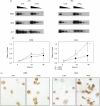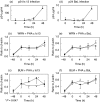Expression of Werner and Bloom syndrome genes is differentially regulated by in vitro HIV-1 infection of peripheral blood mononuclear cells
- PMID: 15498034
- PMCID: PMC1809202
- DOI: 10.1111/j.1365-2249.2004.02622.x
Expression of Werner and Bloom syndrome genes is differentially regulated by in vitro HIV-1 infection of peripheral blood mononuclear cells
Abstract
In HIV infection, continuous immune activation leads to accelerated ageing of the adaptive immune system, similar to that observed in elderly people. We investigated the expression of WRN and BLM (genes involved in disorders characterized by premature ageing, genomic instability and cancer predisposition) in peripheral blood mononuclear cells (PBMC) activated in vitro with phytohaemagglutinin (PHA) and infected with different HIV-1 strains. The steady state levels of mRNA were analysed by reverse transcription-polymerase chain reaction (RT-PCR), and protein expression was assayed using immunocytochemistry and Western blot techniques. In uninfected PBMC, PHA stimulation induced an increase in BLM mRNA and protein expression, while WRN expression remained virtually unchanged. When PBMC were infected in vitro with a lymphotropic HIV-1 strain, the level of BLM mRNA showed a peak at 24 h of infection, followed by a decline to uninfected culture levels. A similar result failed to be seen using an R5-tropic HIV-1 strain. In accordance with mRNA expression, in HIV-infected cultures PBMC were stained more frequently and more intensely by a BLM-specific antibody as compared to uninfected cultures, staining peaking at 24. Conversely, WRN expression was not modulated by HIV-1. The proportion of cells showing BLM up-regulation, established by immunocytochemical staining, was much greater than the proportion of productively infected PBMC, as established by proviral DNA measurement. This result indicates that BLM up-regulation is probably a result of an indirect bystander cell effect. Activation of the BLM gene in infected PBMC suggests that premature ageing could be a further immunopathogenetic mechanism involved in HIV-induced immunodeficiency, and points to a possible new candidate target for innovative therapeutic intervention.
Figures



Similar articles
-
Differential expression of Werner and Bloom syndrome genes in the peripheral blood of HIV-1 infected patients.Hum Immunol. 2007 Feb;68(2):91-9. doi: 10.1016/j.humimm.2006.11.004. Epub 2006 Dec 22. Hum Immunol. 2007. PMID: 17321898
-
Competition between the DNA unwinding and strand pairing activities of the Werner and Bloom syndrome proteins.BMC Mol Biol. 2006 Jan 13;7:1. doi: 10.1186/1471-2199-7-1. BMC Mol Biol. 2006. PMID: 16412221 Free PMC article.
-
Localization of the Bloom syndrome helicase to punctate nuclear structures and the nuclear matrix and regulation during the cell cycle: comparison with the Werner's syndrome helicase.Mol Carcinog. 1999 Dec;26(4):261-73. doi: 10.1002/(sici)1098-2744(199912)26:4<261::aid-mc5>3.0.co;2-a. Mol Carcinog. 1999. PMID: 10569803
-
Werner syndrome: entering the helicase era.Bioessays. 1996 Dec;18(12):1025-7. doi: 10.1002/bies.950181214. Bioessays. 1996. PMID: 8976161 Review.
-
DNA helicase deficiencies associated with cancer predisposition and premature ageing disorders.Hum Mol Genet. 2001 Apr;10(7):741-6. doi: 10.1093/hmg/10.7.741. Hum Mol Genet. 2001. PMID: 11257107 Review.
References
-
- Marrack P, Mitchell T, Hildeman D. Genomic-scale analysis of gene expression in resting and activated T cells. Curr Opin Immmunol. 2000;12:206–9. - PubMed
-
- Nakayama K, Irino N, Nakayama H. The RecQ gene of Escherichia coli K12: molecular cloning and isolation of insertion mutants. Mol Gen Genet. 1985;200:266–71. - PubMed
Publication types
MeSH terms
Substances
LinkOut - more resources
Full Text Sources
Medical

